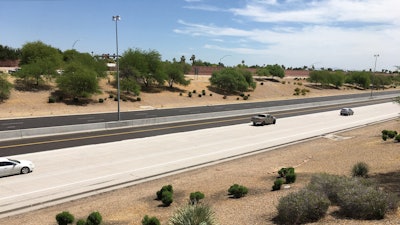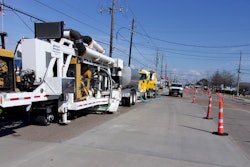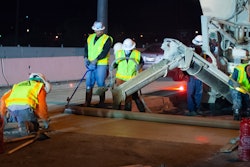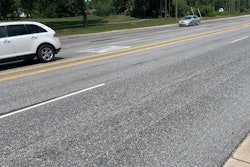
This article is based on a webinar originally presented during the International Grooving & Grinding Association (IGGA) Technical Sessions, Dec. 2020. Watch the full presentation below.
Phoenix-area residents expect smooth, beautiful, quiet roads. But due to explosive population growth in the region and funding insufficient to keep pace, pavement conditions across the area have been declining over the last decade. The Arizona Department of Transportation (ADOT) is examining creative solutions for maintaining its highway network and delivering the kind of roads the public expects.
Phoenix is the fifth most populous city in the U.S., and it is growing. All 435 miles of the city’s road and bridge network, most of which consists of four-lane highways with additional high-occupancy vehicle (HOV) lanes, is maintained by the Arizona Department of Transportation (ADOT) Central District. With a $500-million-per-year construction budget, the district typically conducts 20 to 25 construction projects per year on the high-volume road network.
Arizona’s Pavement History
Arizona has used concrete pavement since the 1920s. Concrete lasts for decades and requires maintenance only every 20-25 years. For Arizona, 40 years of success with the material led to its use when the state’s main highways were being built in the 1960s. At that time, paving with concrete meant making trade-offs when it came to road noise. During that period, the concrete surface was finished by tining (pulling a metal rake across the concrete surface perpendicular to traffic flow), and tires traveling over tined concrete generate a noisy, tonal whine. In 2003, to address the noise, a 1-in. asphaltic rubber friction course (AR-ACFC) was applied on top of the Portland Cement Concrete (PCC). This delivered a consistent look, quiet sound, and comfortable travel. However, preserving the AR-ACFC surfaces has proved to be a challenge.
AR-ACFC has a design life of approximately 10 years. Arizona’s highways have now exceeded that design life and are showing their age. Delamination and related issues are creating problems for both drivers and the DOT. Although delamination typically only causes the loss of about an inch of pavement depth (as the 1 in. of rubber asphalt has separated from the concrete underneath), delaminated spots are perceived as potholes by the traveling public and are regarded as a serious problem.
 After testing diamond grinding, Next Generation Concrete Surface, and finishing concrete surfaces with a skid abrader or micro-milling, ADOT determined that the longitudinal texture achieved with diamond grinding offered a pleasing corduroy appearance as well as a nice ride (as indicated by low IRI numbers) and low sound emissions.Randy Everett & the Arizona Department of Transportation
After testing diamond grinding, Next Generation Concrete Surface, and finishing concrete surfaces with a skid abrader or micro-milling, ADOT determined that the longitudinal texture achieved with diamond grinding offered a pleasing corduroy appearance as well as a nice ride (as indicated by low IRI numbers) and low sound emissions.Randy Everett & the Arizona Department of Transportation
Arizona measures pavement condition by the International Roughness Index (IRI), and numbers have been trending down. (The IRI is a roughness statistic that is almost universally used by state agencies as a performance metric for their pavement management systems, with lower numbers, and therefore less roughness, being desirable). According to IRI measurements taken in 2010, 72% of the area’s interstates were in good condition. By 2018, that percentage dropped to 53%. National Highway System routes are also trending down, with 2010 measurements showing 68% of the highways in good condition and the number falling to 35% by 2018.
With costs mounting—and budgets not keeping up—in April 2019 ADOT started to look for better preservation options than what had historically been in their toolbox. For pavement within the 10-to-15-year design life window that was still in good condition—and it is increasingly important for the department to keep existing pavement in good condition—options included crack sealing the pavement, fog sealing (applying a light coat of diluted, slow-setting asphalt emulsion), or repairing individual potholes. For pavement past its design life, one option was to mill off the deteriorated asphalt and put down a new rubberized asphalt overlay. This, however, proved cost-prohibitive due to the extent of the area needing repair. Another deterrent to any solution requiring repeated milling of the asphalt surface was that milling equipment inevitably impacts and damages the underlying concrete, with joints experiencing particularly severe loss of concrete material.
What if Arizona went back to its original PCC surfaces? ADOT knew the state’s concrete highways were designed to offer a long life of structural stability. The department realized that if they could use the underlying PCC, making improvements to its original tined surface that would result in a quiet and rideable roadway, the rehabilitated roadways might last a lot longer while requiring much less maintenance than asphalt.
A Return to Concrete Pavements: Pilot Studies
An AR-ACFC layer had already been removed as part of a project being conducted on SR 101 in the northern part of Phoenix, so ADOT installed four test sections to explore future solutions that would take advantage of the existing concrete while ensuring a smooth, quiet ride and good pavement appearance. The department reviewed diamond grinding as well as the Next Generation Concrete Surface (NGCS), which is a texture with a controlled land profile and an overall negative or downward texture developed to be a particularly low-noise concrete pavement surface. ADOT also considered finishing concrete surfaces with a skid abrader (a process in which a machine directs ball bearings at the pavement to improve friction characteristics) or with micro-milling. After testing each method, ADOT determined that the longitudinal texture achieved with diamond grinding offered a pleasing corduroy appearance as well as a nice ride (as indicated by low IRI numbers) and low sound emissions. The diamond-grinding process also proved to be gentle enough to protect areas of the concrete, especially around joints, that had previously been damaged by milling. Diamond grinding was also a cost-effective solution.
In May 2019, ADOT decided to diamond grind a short section of SR 202, located in the southern Phoenix area. This stretch of road, which had 15-year-old AR-ACFC, was badly raveling and delaminating, to the point that loose rock was being thrown at windshields with daily complaints from drivers that windshields had been damaged by the flying rock. The area was seeing a higher percentage of damage claims than the rest of the nation. The pavement was also very loud and rough to drive on. ADOT selected a diamond-ground finish for the two right lanes along a half-mile stretch of SR 202. They removed existing AR-ACFC layers without damaging underlying concrete by using a loader bucket, a method the department had successfully experimented with in April when they were brainstorming ways to return to PCC road surfaces. After project completion, ADOT representatives noticed that drivers would move from the AR-ACFC lanes to the diamond-ground concrete lanes to experience the improved ride and sound characteristics.
 Even though not all pilot projects have been completed, initial findings on costs suggest that savings associated with using concrete road surfaces, diamond-ground to optimize appearance, smoothness, and sound, could be as much as a $3.9 billion reduction in maintenance costs over a 30-year period.Randy Everett & the Arizona Department of Transportation
Even though not all pilot projects have been completed, initial findings on costs suggest that savings associated with using concrete road surfaces, diamond-ground to optimize appearance, smoothness, and sound, could be as much as a $3.9 billion reduction in maintenance costs over a 30-year period.Randy Everett & the Arizona Department of Transportation
At about this time, a Maricopa Association of Governments (MAG) report came out assessing the noise and rideability of local freeways. The report acknowledged the difficulty of maintaining the road network and also focused on the noise characteristics of the road. A key takeaway was that, since the noise benefits of AR-ACFC vanish so quickly, “consideration should be given to replacement of the rubberized asphalt overlay with a diamond ground treatment.” Another concurrent development was a maintenance procurement contract that allowed diamond grinding contractors to be brought in for maintenance as well as for construction.
ADOT felt it was time to take the next step and scheduled a bigger diamond grinding project on SR 202 for February 2020. This project covered a four-mile section that was four lanes wide, with ramp sections included. The area was too big to remove asphalt using a loader, so a milling machine was used. The department cut strips in the rubberized asphalt to be used by the milling contractor as a guide during the milling process. By allowing the operator to more easily see the PCC surface below the overlay, milling equipment could be adjusted and damage to underlying concrete was minimized. The final diamond-ground surface of SR 202 met all ADOT’s criteria—it was quiet, smooth, and attractive—with IRI numbers in the 20s and 30s comparing very favorably to asphalt surfaces. These comparable noise characteristics were achieved because, while new AR-ACFC pavement is about 5 dB quieter than diamond-ground surfaces, by the time AR-ACFC pavement is five to nine years old it is measuring at comparable or higher dB levels. Not only were noise levels on the new SR 202 diamond-ground surface low for drivers but the pavements generated less noise in nearby neighborhoods.
The success of their early projects prompted ADOT to begin three other diamond grinding pilot projects. Diamond grinding on the Loop 101 Price Freeway has been completed. Diamond grinding on the Loop 101 Pima Freeway took place in early 2021 and the Loop 101 I-17 to 75th Avenue construction project is expected to occur within the next five years. ADOT will be tracking the performance of all projects to see how joints are holding up, whether the concrete spalls and how well sound and ride quality are maintained.
Even though not all pilot projects have been completed, data collected so far justifies consideration of diamond grinding as an alternative to the standard mill and fill. Initial findings on costs suggest that savings associated with using concrete road surfaces, diamond-ground to optimize appearance, smoothness, and sound, could be as much as a $3.9 billion reduction in maintenance costs over a 30-year period.
By using existing concrete pavement in Phoenix, not only will maintenance budgets stretch farther and allow more roads to be kept in good condition, but concrete’s durability ensures that interruptions associated with road repair will be minimized. Most importantly, the public will be able to enjoy driving surfaces that are smooth and quiet.
About the author
Randy Everett is the Senior Division Administrator, Arizona Department of Transportation, Central District.
This article is based on a webinar originally presented during the IGGA Technical Sessions, Dec. 2020.
The IGGA is a non-profit trade association founded in 1972 by a group of dedicated industry professionals committed to the development of the diamond grinding and grooving process for surfaces constructed with Portland cement concrete and asphalt. In 1995, the IGGA joined in affiliation with the American Concrete Pavement Association (ACPA) to form today what is known as the IGGA/ACPA Concrete Pavement Preservation Partnership (IGGA/ACPA CP3). Today this partnership serves as the technical resource and industry leader in the marketing of optimized pavement surfaces, concrete pavement restoration, and pavement preservation around the world. The mission of the IGGA is to serve as the leading technical and promotional resource for the acceptance and proper use of diamond grinding and grooving as well as PCC preservation and restoration.


















